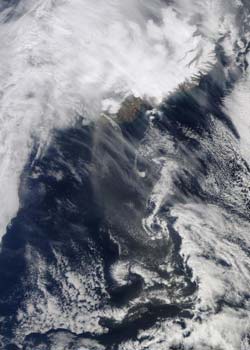NASA's Terra satellite keeps eye on Eyjafjallajökull's ash plume

The MODIS instrument on NASA\'s Terra satellite captured a visible image of the ash plume (brown) drifting south and east from Eyjafjallajökull volcano in Iceland at 11:55 UTC (7:55 a.m. EDT). Credit: NASA\'s MODIS Rapid Response Team<br>
The Moderate Resolution Imaging Spectroradiometer (MODIS) instrument on NASA's Terra satellite captured visible image of the ash plume (consisting of fine particles of pulverized rock) at 11:55 UTC (7:55 a.m. EDT). The plume appeared to be lighter in color than the previous few days, and it was drifting south and east over the Northern Atlantic Ocean.
NASA works with other agencies on using satellite observations to aid in the detection and monitoring of aviation hazards caused by volcanic ash. For more on this NASA program, visit:
http://science.larc.nasa.gov/
asap/research-ash.html
The MODIS Rapid Response System was developed to provide daily satellite images of the Earth's landmasses in near real time. The MODIS Rapid Response Team that generates the images is located at NASA's Goddard Space Flight Center in Greenbelt, Md.
Media Contact
More Information:
http://www.nasa.govAll latest news from the category: Earth Sciences
Earth Sciences (also referred to as Geosciences), which deals with basic issues surrounding our planet, plays a vital role in the area of energy and raw materials supply.
Earth Sciences comprises subjects such as geology, geography, geological informatics, paleontology, mineralogy, petrography, crystallography, geophysics, geodesy, glaciology, cartography, photogrammetry, meteorology and seismology, early-warning systems, earthquake research and polar research.
Newest articles

Sea slugs inspire highly stretchable biomedical sensor
USC Viterbi School of Engineering researcher Hangbo Zhao presents findings on highly stretchable and customizable microneedles for application in fields including neuroscience, tissue engineering, and wearable bioelectronics. The revolution in…

Twisting and binding matter waves with photons in a cavity
Precisely measuring the energy states of individual atoms has been a historical challenge for physicists due to atomic recoil. When an atom interacts with a photon, the atom “recoils” in…

Nanotubes, nanoparticles, and antibodies detect tiny amounts of fentanyl
New sensor is six orders of magnitude more sensitive than the next best thing. A research team at Pitt led by Alexander Star, a chemistry professor in the Kenneth P. Dietrich…





















